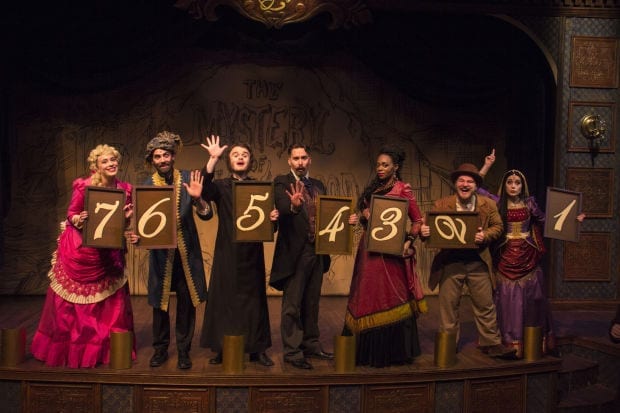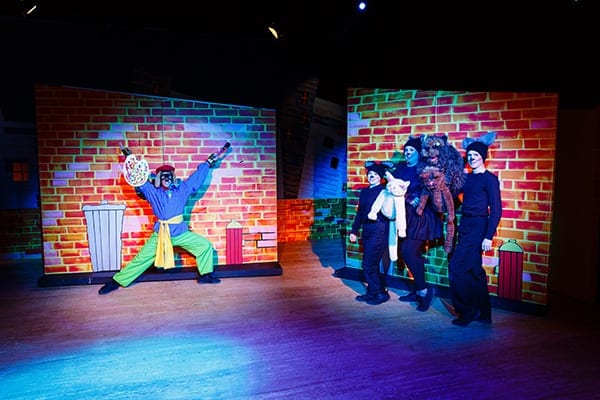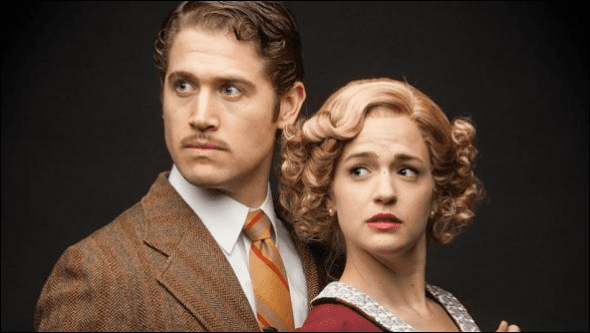OREM — One of the great tragedies of nineteenth century English literature is that Charles Dickens died right in the middle of writing his final novel, The Mystery of Edwin Drood. Literary scholars have their own opinions about how Dickens meant to wrap up all the play’s dangling plot points, but playwright Rupert Holmes has chosen to leave the destiny of the book’s central characters up to democratic vote. The result is a Choose-Your-Own-Adventure-style Broadway musical, currently playing at Utah Valley University.
The Noorda Theatre stage bears an ornate façade stylized as a music hall in Victorian England, and Jordan Cummings plays William Cartwright, the theater’s master of ceremonies. He narrates the audience’s way through a play-within-a-play as the cast portray a troupe of Victorian actors performing on opening night. The stage is backed with various painted backdrops and sundry furniture, and the action continues off-stage with seats for the cast to occupy when their characters aren’t on stage (scenic & properties design by Daniel Whiting). Throughout the evening the actors participate from the sidelines, and the music hall’s stage manager (played by Alex Rettie) even provides sound effects with various make-shift devices.
Director Rob Moffat used the play-within-a-play format to infuse the show with lighthearted asides and comic relief. The cast also skillfully use their dual characters to engage the audience for the play’s interactive ending, in which the audience vote on several key plot points. (There are some 420 possible ways the votes can combine to close the play.) As actors played their dual roles, they wore authentic looking Victorian garb and wigs, sometimes topped with additional costume pieces that could be exchanged between characters when the actors needed to swop roles (costume design by Amanda Shaffer; hair and makeup by Clarissa Lavon Knotts).
The first act of The Mystery of Edwin Drood methodically introduces the key suspects in the forthcoming crime. The most obvious suspect is John Jasper (played by Jacob Theo Squire), uncle and confidante to Edwin Drood. Jasper quickly reveals himself to the audience as a two-faced cad who uses his role as her vocal coach to torment Drood’s fiancée, Rosa Bud, with his lewd advances. Jasper’s dastardly demeanor couldn’t contrast more with his nephew’s; Drood is portrayed by Riley Branning in the role of the spunky Alice Nutting, Victorian London’s most renowned male impersonator. Branning lent the character of Drood a spritely joviality with her faux-mannish gait and exaggeratedly mannerisms.
 The Reverend Crisparkle and his wards, Helena and Neville Landless, are the next suspects to arrive on the scene. Recently orphaned, Helena and Neville have just arrived from an unnamed British colony. The Landless siblings spark a quick rivalry with the nationalistic Drood who is annoyed by the way they mingle their foreign dress and culture with English civility. Portrayed by Alex Woods and Amber Dodge, the Landless siblings are easily my favorite characters in the play, as they treat everyone with suspicion, shift their eyes ominously while speaking in mysterious accents, and exhibit mannerisms vaguely reminiscent of dances from almost anywhere east of Western Europe.
The Reverend Crisparkle and his wards, Helena and Neville Landless, are the next suspects to arrive on the scene. Recently orphaned, Helena and Neville have just arrived from an unnamed British colony. The Landless siblings spark a quick rivalry with the nationalistic Drood who is annoyed by the way they mingle their foreign dress and culture with English civility. Portrayed by Alex Woods and Amber Dodge, the Landless siblings are easily my favorite characters in the play, as they treat everyone with suspicion, shift their eyes ominously while speaking in mysterious accents, and exhibit mannerisms vaguely reminiscent of dances from almost anywhere east of Western Europe.
The Reverend Crisparkle (played by Spicer Carr) dotes paternally on his wards and is as absentmindedly jolly as they are cautiously somber. Despite all his flamboyant cheer and quirky accent (whose nationality was more ambiguous than the Landlesses’, though possibly not intentionally), Crisparkle betrays a past that might not be as spotless as one tends to expect from a man of the cloth.
When Jasper begins mingling with society’s criminal element, a slew of potential threats Drood isn’t even aware he should fear enter the scene. Princess Puffer (played by Erika Ovuoba) manages a house of ill repute where she deals in both opium and, ahem, women. Ovuoba mingled coquettish humor with an underlying deep sadness, making Puffer one of the most complex characters in the play. The hallucination sequence in Princess Puffer’s brothel was one of the most artistically interesting in the play. While under the influence of opiates, Jasper imagines a scene between himself (portrayed magnificently in dream-form Kacey Spadafora), Drood, and Rosa Bud. All the while, the brothel’s pastimes are suggested through dance by the very talented Rachel Bigler, Brenna Grace Christen, Kailey Azure Green, Trevor Elzey, and cast members doubling elsewhere (choreography by Dave Tinney). The subject matter is handled with great taste, and I don’t expect conservative audiences would find the brothel scenes offensive.
Before long, Jasper enlists the service of a working fellow named Durdles (DeGrey Christensen) and his assistant (Thayne Caldwell), as well as the bumbling servant Bazzard (C. McKay Nicoll), to carry out his surreptitious bidding. Nicoll is a constant source of entertainment in the role of Phillip Bax, the Victorian-era actor playing Bazzard. Bax is eager for a chance to prove his dramatic talent and milks the melodrama out of every scene, even when he’s only serving dinner. I was thrilled when the Cartwright allowed Bax to perform a solo song and dance number to show off his skills.
In true whodunit fashion, everyone is a suspect: despite her innocent demeanor and angelic voice, suspicion falls even upon Drood’s fiancée, Rosa Bud (Jenny Latimer). An orphan whose marriage to Drood has been anticipated since childhood, is it possible that Bud’s feelings toward her fiancé are anything less-than romantic? Or does she have eyes for a certain recently orphaned new arrival from the Commonweath? And considering that Bud is an orphan, does she need to avenge her parents’ death on anyone? Are any of these questions even important? Only a two-act musical will tell.
Even though I’m struggling to describe the dual-play format without sounding like I’m explain Inception to someone who hasn’t seen it, I want to assure readers that Holmes’s script is a witty pleasure with endearing characters and an easily understandable story. The arrangement of the stage, the use of lighting (designed by Casey Price), and Jordan Cummings’ narration as Cartwright make it easy to know which of their roles the actors occupy at any given time. The recorded instrumental accompaniment blends easily with Alex Rettie’s makeshift Victorian sound effects (thanks to the sound design by Jason Sullivan). And on top of that all, the actors are all vocally and comically talented enough to magnify all the charm inherent in their parts.
UVU’s The Mystery of Edwin Drood does exactly what it set out to do. I was engaged by the humor and mystery of the play from start to finish. UVU’s cast and crew skillfully capture Charles Dickens’s unique style of writing, and the democratic handling of the open-ended script milks more humor out of an unfinished novel than I imagined possible. This is one of those rare plays that I can recommend to anyone—no matter how new to either theater or Dickens—and confidently promise an absolutely delightful evening.






